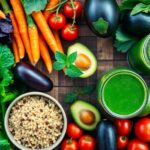The GAPS Diet, or Gut and Psychology Syndrome Diet, links gut health to mental wellness. It emphasizes nutrient-dense foods like bone broth, fermented items, and high-quality proteins while avoiding grains, sugar, and processed foods. Following a structured, stage-based approach, the diet aims to heal the gut and improve various aspects of health, including digestion and emotional stability. You can experience benefits like improved mood, mental clarity, and better immune function. However, challenges like meal planning may arise. To navigate these effectively, there are plenty of resources and tips that can help you on this journey.
Key Takeaways
- The GAPS Diet focuses on improving gut health to enhance mental well-being and emotional stability.
- It includes nutrient-rich foods like bone broth, fermented foods, and high-quality proteins while avoiding grains and processed foods.
- The diet is structured in stages to facilitate gradual gut healing and personalized dietary adjustments.
- Key benefits include improved digestion, mood stabilization, mental clarity, and overall health enhancement.
- Success can be supported through meal planning, community resources, and experimenting with recipes that promote nutrient density.
Overview of the GAPS Diet

The GAPS Diet, which stands for Gut and Psychology Syndrome, is designed to heal the gut and improve mental health by focusing on nutrient-rich foods. This approach emphasizes the connection between gut health and mental wellness, recognizing that what you eat can greatly impact your mood and cognitive function.
You'll start by eliminating processed foods, sugars, and grains, making way for wholesome options like bone broth, fermented foods, and high-quality proteins. These foods are abundant in vitamins and minerals that support gut healing. By prioritizing nutrient-rich choices, you're not just nourishing your body; you're also fostering a healthier environment for your gut microbiome.
The GAPS Diet is structured in stages. Initially, you'll follow a strict protocol to allow your gut time to heal. As you progress, you can gradually reintroduce certain foods, monitoring how they affect your digestion and mental clarity. This personalized approach encourages you to tune into your body's responses, fostering a sense of empowerment and connection.
Moreover, understanding the pivotal role of gut health in mental wellness can help you feel less isolated in your journey. Many people experience similar challenges, and by embracing this diet, you're joining a community seeking balance and healing. Ultimately, the GAPS Diet isn't just a diet; it's a lifestyle choice that supports your overall well-being.
As you set out on this path, you're taking meaningful steps toward achieving a healthier gut and a more positive mindset. Additionally, avoiding traditional bread consumption can further enhance your gut health and support your mental wellness journey.
The Science Behind GAPS
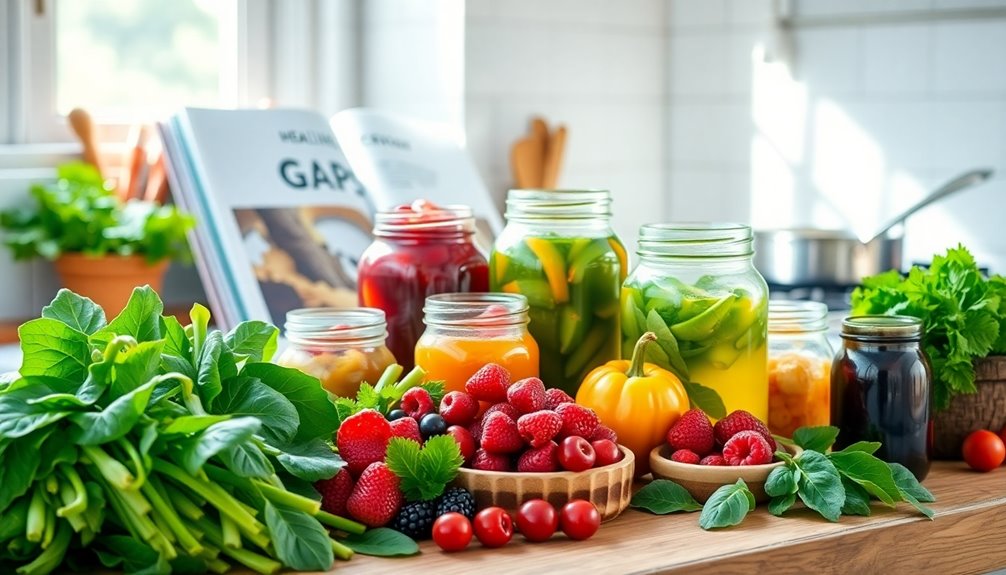
Understanding the science behind the GAPS Diet reveals how gut health directly influences mental and physical well-being. The gut microbiome, a complex community of microorganisms living in your digestive tract, plays an essential role in regulating various bodily functions, including mental health. Research suggests that an imbalance in this microbiome can lead to issues like anxiety and depression.
To better understand this relationship, let's break down some key components of the GAPS Diet and how they relate to gut health and mental well-being:
| Component | Role in Gut Health | Impact on Mental Health |
|---|---|---|
| Probiotics | Support the growth of beneficial bacteria | May reduce anxiety and improve mood |
| Fermented foods | Enhance gut microbiome diversity | Linked to improved cognitive function |
| Bone broth | Rich in collagen and amino acids | Supports gut lining, potentially reducing inflammation |
| Nutrient-dense meals | Provide essential vitamins and minerals | Important for neurotransmitter production |
| Low-carb, high-fat | Stabilizes blood sugar levels | May reduce mood swings and irritability |
Additionally, maintaining a healthy gut microbiome is essential for preventing diseases that can worsen chronic conditions like CKD.
Benefits of the GAPS Diet
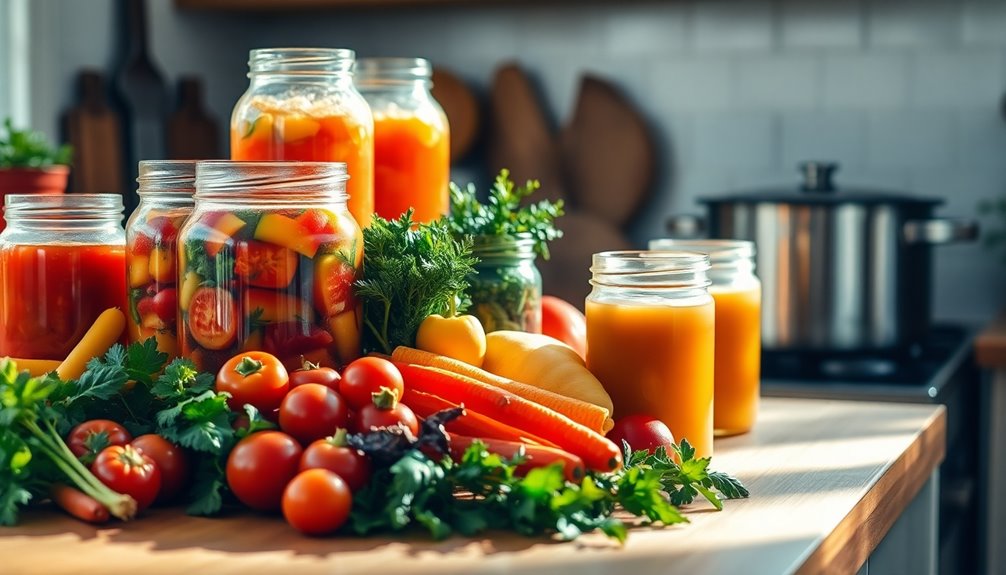
GAPS Diet enthusiasts often highlight its many advantages, particularly in promoting gut health and overall well-being. One of the most significant benefits you'll notice is improved digestion. By focusing on nutrient-rich foods that are easy to digest, many individuals report experiencing reduced bloating, gas, and discomfort. This can create a more enjoyable eating experience and encourage a healthier relationship with food.
Another notable advantage is the potential for enhanced immune function. A healthy gut microbiome plays a vital role in your body's ability to fend off infections and illnesses. By following the GAPS Diet, you may build a stronger immune system, which can lead to fewer sick days and a greater sense of liveliness.
Many adherents also express experiencing improved mental clarity. This can be attributed to the gut-brain connection, where a healthy gut can positively influence cognitive function. You may find that your focus and concentration improve, allowing you to tackle daily tasks with greater ease.
Additionally, mood stability is often a reported benefit of the GAPS Diet. As you nourish your body with wholesome foods, you may feel more balanced emotionally. This can lead to a reduction in anxiety and mood swings, helping you cultivate a more serene state of mind. Moreover, adopting a plant-based diet can further enhance your overall health and vitality, complementing the benefits of the GAPS Diet.
Foods to Include
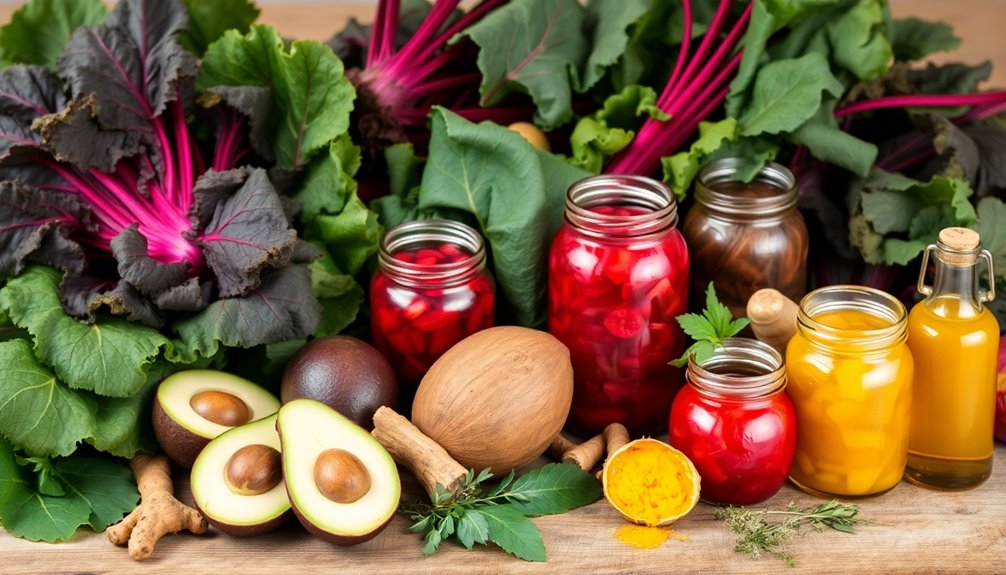
When starting on the GAPS Diet, you'll want to focus on incorporating a variety of nourishing, whole foods that support gut health and overall wellness. This diet emphasizes the importance of real, unprocessed foods that are gentle on your digestive system. Think about including plenty of bone broth, which is rich in collagen and minerals, as it can help mend your gut lining.
Fresh vegetables, particularly non-starchy ones like leafy greens, carrots, and zucchini, provide essential nutrients and fiber.
Consider adding fermented foods like sauerkraut, kimchi, and yogurt made from grass-fed milk. These foods are packed with probiotics, which can improve your gut microbiome.
High-quality fats, such as ghee, coconut oil, and olive oil, are also vital for maintaining nutritional balance and providing energy.
When it comes to protein sources, focus on grass-fed meats, wild-caught fish, and free-range poultry. These options not only provide essential amino acids but also contain healthy fats that are beneficial for your body.
As you plan your meals, aim for variety to make sure you're receiving a wide range of nutrients.
Meal planning can be a game-changer on the GAPS Diet. By preparing your meals in advance, you'll find it easier to stick to the foods that promote healing and avoid unhealthy options. Additionally, including natural neuropathy relief can support overall wellness while nourishing your body with the right foods. Remember, it's all about creating a supportive environment for your gut health while nourishing your body with the right foods.
Foods to Avoid
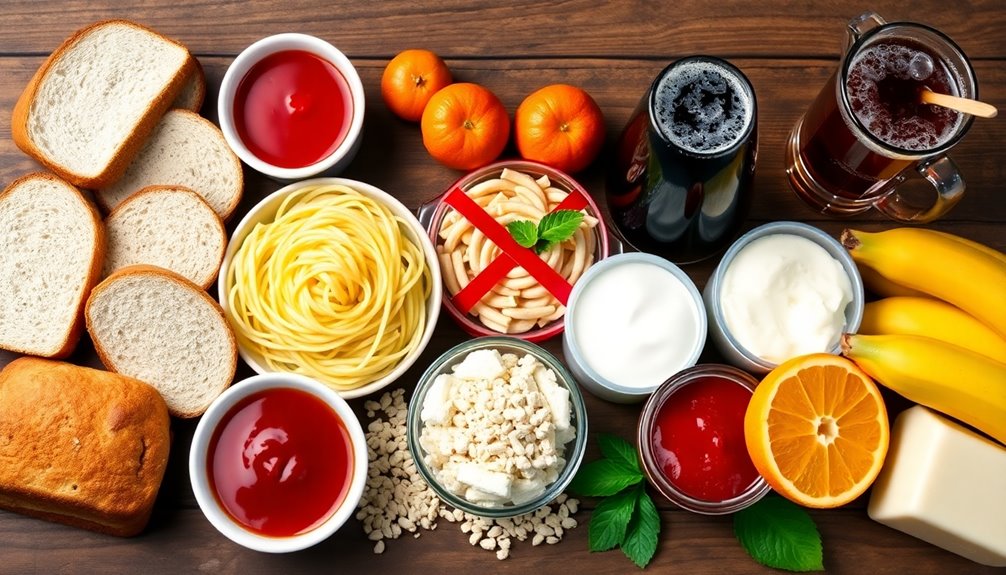
To successfully navigate the GAPS Diet, understanding the foods you should avoid is crucial. This diet focuses on improving gut health, and certain items can act as food triggers, exacerbating symptoms related to autoimmune disorders, digestive issues, and psychological conditions.
First off, you'll want to steer clear of grains. Wheat, corn, and rice can disrupt your gut's balance, causing inflammation and hindering your healing process.
Sugar is another culprit; it feeds harmful bacteria and can worsen gut dysbiosis. Processed foods and additives, packed with chemicals and preservatives, often contain hidden sugars and unhealthy fats that can sabotage your progress.
Dairy can also be tricky. While some fermented dairy products may be permissible later in the diet, fresh milk and certain cheeses can lead to issues for those with sensitivities. Additionally, legumes are generally avoided, as they can be hard for your body to digest and may trigger unwanted reactions.
Nightshade vegetables like tomatoes, potatoes, and eggplants can also be problematic for some people, especially those with autoimmune conditions. Following a diet that eliminates these foods can help align with natural cycles of food intake, promoting better overall health and supporting your body's healing process.
Stages of the GAPS Diet

The GAPS Diet is structured into distinct stages, each designed to gradually heal the gut and restore balance. You'll find that the progression through these stages allows for effective meal planning and helps you monitor your progress tracking. By adhering to these stages, you can tailor your nutritional approach to best suit your needs.
| Stage | Focus Area | Key Foods |
|---|---|---|
| Stage 1 | Introduction | Bone broth, soft-cooked meats |
| Stage 2 | Building | Fermented foods, vegetables |
| Stage 3 | Expansion | Nuts, seeds, dairy products |
In Stage 1, you'll start with easily digestible foods such as bone broth and soft-cooked meats. This allows your body to begin the healing process. As you move to Stage 2, you can introduce fermented foods and cooked vegetables, which further support gut health. Finally, in Stage 3, you'll expand your diet to include nuts, seeds, and dairy products, provided you tolerate them well. Incorporating whole-food sources of nutrients can enhance your overall health during this process.
Throughout this journey, consistent progress tracking is essential. Keeping a food journal can help you identify what works for you and what doesn't. This way, you can adjust your meal planning as needed. Remember, everyone's journey is unique, so listen to your body and progress at your own pace. Embracing these stages will not only support your gut health but also foster a sense of community with others on similar paths.
Common Challenges

Progressing through the stages of the GAPS Diet can present various challenges that may impact your commitment and success. One of the most significant hurdles is meal planning. Without a structured approach, it's easy to feel overwhelmed by the restrictions and complexities of GAPS.
You might find yourself stuck in a rut, repeating the same meals, or struggling to create balanced, nutrient-dense options. It's crucial to dedicate time to plan your meals, ensuring you have a variety of ingredients and recipes on hand to keep things interesting and nutritious.
Another challenge arises during social gatherings. Facing events where food is involved can be intimidating when you're following the GAPS Diet. You may feel isolated or pressured to indulge in foods that don't align with your dietary goals.
To address this, consider communicating your dietary needs with friends and family ahead of time. You can also bring your own dishes, allowing you to enjoy the social aspect without compromising your commitment to the diet.
Staying connected with others who understand the GAPS Diet can also provide a sense of belonging and support. Online forums and local groups can offer encouragement, recipe ideas, and tips for overcoming these challenges. Additionally, independent research confirms the effectiveness of the 3X Diet System, which may provide valuable insights into enhancing your overall well-being while following a strict diet.
Recipes for Success
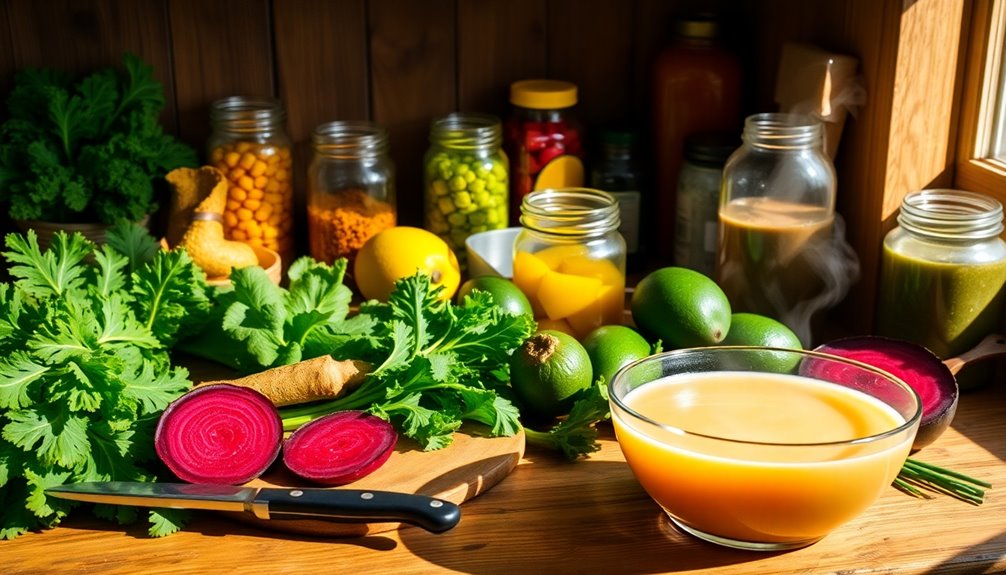
Finding delicious and satisfying recipes is essential for thriving on the GAPS Diet. When you focus on meal planning, you set yourself up for success by ensuring you have a variety of nourishing options at your fingertips. This approach not only helps you stay on track but also makes it easier to share meals with family and friends, fostering a sense of belonging.
Start by exploring simple, GAPS-friendly recipes that highlight nutrient-dense ingredients like bone broth, fermented foods, and fresh vegetables. You can create hearty soups, stews, and casseroles that warm the soul while supporting gut health.
For breakfast, consider options like scrambled eggs with sautéed greens or smoothies made with coconut milk and nut butter.
Incorporating cooking tips can elevate your experience. Batch cooking is a game-changer; prepare large quantities of staple dishes and freeze portions for later. This makes it easier to adhere to the diet during busy weeks. Additionally, experimenting with herbs and spices can enhance flavors without compromising dietary restrictions, making meals more enjoyable.
Don't hesitate to involve your loved ones in the cooking process. This not only builds community but also provides an opportunity to educate others about the GAPS Diet. By sharing recipes and tips, you create a supportive environment where everyone can thrive together. Remember, the journey to better health isn't just about food—it's about connection and shared experiences. Furthermore, incorporating effective exercise routines can complement your dietary changes and enhance overall well-being.
Testimonials and Success Stories

Many individuals have successfully transformed their health through the GAPS Diet, sharing inspiring testimonials that highlight significant improvements in their well-being. These personal experiences often reveal the profound impact the diet can have on both physical and mental health.
Here are four notable transformations shared by GAPS Diet practitioners:
- Improved Digestion: Many report that after adopting the GAPS Diet, they experienced a reduction in bloating, gas, and digestive discomfort. This relief often leads to a renewed sense of energy and vitality.
- Enhanced Mental Clarity: People have often stated that following the diet resulted in better focus and cognitive function. The connection between gut health and mental acuity becomes clearer as individuals notice changes in their ability to concentrate.
- Emotional Stability: Numerous testimonials highlight the emotional benefits of the GAPS Diet. Individuals have shared stories of reduced anxiety and mood swings, leading to a more balanced emotional state.
- Stronger Immunity: Some have experienced fewer illnesses since implementing the GAPS Diet, attributing this to improved gut health, which plays an essential role in immune function.
Additionally, many participants have noted that the detox program included in their dietary changes has further enhanced their overall health journey.
These testimonials not only emphasize the potential transformations but also foster a sense of community among those seeking similar improvements. By sharing your story or learning from others, you can feel more connected and supported on your journey toward better health through the GAPS Diet.
Getting Started With GAPS

Having heard inspiring testimonials from those who've transformed their health with the GAPS Diet, you might be enthusiastic to start your own journey. The first step is to understand that this diet involves significant lifestyle changes, focusing on healing your gut and improving mental clarity. It's vital to approach this with a plan.
Meal planning is pivotal to your success. Begin by creating a weekly menu that incorporates GAPS-approved foods. Focus on bone broths, fermented foods, and fresh vegetables while avoiding grains, sugars, and processed items. Preparing meals in advance can save you time and keep you motivated. Consider batch cooking and storing portions in the freezer for busy days.
Next, educate yourself about the phases of the GAPS Diet. Starting with the Introduction Phase can be beneficial, as it gradually reintroduces foods, allowing your body to adapt. Remember, patience is crucial; you're on a journey, not a race.
Don't hesitate to seek support from GAPS communities, both online and offline. Engaging with others who share your goals can provide encouragement and accountability. They can also offer tips and share their experiences, making you feel less isolated in your changes.
Lastly, keep a journal to track your progress, noting any improvements in your health and well-being. This can be incredibly motivating and help clarify what works best for you. Embrace this journey, and remember that every positive change counts! Additionally, understand that strong glutes can contribute to overall body performance, which may enhance your physical activities during this dietary transition.
Frequently Asked Questions
Can Children Follow the GAPS Diet Safely?
When considering if children can safely follow a specific diet, it's important to weigh the benefits and risks. Nutritional support is necessary for their development, so make sure the diet meets their needs.
While some children may thrive, others might face challenges. Consulting a healthcare professional is crucial to tailor the approach for your child.
Open communication and careful monitoring can help create a balanced experience, fostering a sense of belonging while prioritizing their health.
How Long Should You Stay on the GAPS Diet?
As the old saying goes, "Slow and steady wins the race." When considering how long to stay on a specialized diet, think about long-term effects on your body. Typically, it's best to stay on it for several months to gauge its benefits.
Once you feel ready, shift off gradually to avoid shocking your system. Always consult a healthcare professional to tailor the approach to your needs, ensuring you feel supported throughout the process.
Is the GAPS Diet Suitable for Vegetarians?
The GAPS diet isn't naturally suitable for vegetarians, as it emphasizes animal products for gut health. However, you can adapt it by incorporating plant-based alternatives. Focus on creating a nutritional balance by including fermented foods, legumes, and nuts.
While it may require careful planning, you can still align with the principles of the diet while respecting your dietary choices. Just make sure you're meeting your nutritional needs for peak health and well-being.
Can I Exercise While on the GAPS Diet?
You can absolutely exercise while on a specific diet, but it's wise to listen to your body. Consider exercise modifications that suit your energy levels and nutritional intake.
Focus on low-impact activities like walking or yoga if you're feeling fatigued. Incorporate fitness tips like staying hydrated and eating balanced meals to fuel your workouts.
What Supplements Should I Take on the GAPS Diet?
You might think you can get everything you need from food alone, but supplements can really enhance your well-being. Consider adding probiotics to support your gut health, as they're vital for maintaining balance.
Also, don't forget about essential vitamins like B12, D, and magnesium, which play pivotal roles in overall health. Choosing high-quality supplements can help you feel your best and connect with others on a similar journey.
Conclusion
In your journey through the GAPS Diet, think of yourself as a gardener, nurturing the soil of your gut to cultivate a flourishing mind and body. By embracing nourishing foods while uprooting harmful ones, you're planting the seeds for better health. Challenges may arise, but remember that even the strongest trees face storms. With determination and the right resources, you can thrive. Start today, and watch as your inner garden transforms, yielding a vibrant, healthier you.


